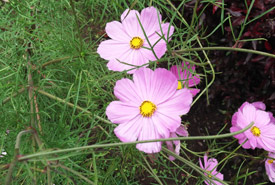
Pink coreopsis (Photo by Yercaud Elango/Wikimedia Commons)
Pink coreopsis
What does it look like?
Pink coreopsis, also known as pink tickseed, is a perennial herbaceous plant. It grows 20- to 60-centimetre-long stalks and pink or white flowers with yellow centres. Its leaves are two to five centimetres long and 0.5 to three millimetres wide.
Where is it found?
Pink coreopsis is found on the gently sloping rocky and sandy shorelines of three lakes in southwestern Nova Scotia’s Tusket River watershed: Salmon, Wilson and Bennett lakes. The plant once occurred along the shores of three other Nova Scotia lakes. However, it became extirpated (locally extinct) in these areas mainly because of increasing water levels from hydroelectric reservoirs. The plant is also found in 10 American states.
This species occurs in open habitats that experience periodic environmental disturbances, including wave action and/or periodic fluctuations in water levels. Pink coreopsis is part of a specialized group of flowering plants called Atlantic Coastal Plains Flora. This plant community lives along the shorelines of lakes, rivers, wetlands and estuaries in the lowlands extending from Nova Scotia to Florida.
How does it reproduce?
Pink coreopsis mainly reproduces asexually through underground runners, or stolons. In Nova Scotia, this happens sporadically because the species is at the northern limit of its range in this province. Flowering requires low water levels and takes place between mid-July and mid-September. The seeds, which resemble ticks, mature towards the end of August and September.
What threats does this species face?
Pink coreopsis faces many threats that negatively impact its habitat. This includes shoreline development, road construction, trampling from recreational activities and lake water pollution.
What is its conservation status?
Sadly, this pretty plant is endangered provincially, nationally and globally. It is protected under the Nova Scotia Endangered Species Act and the Canadian Species at Risk Act.
What is NCC doing to protect habitat for this species?
The Nature Conservancy of Canada (NCC) currently owns and protects around 1.6 kilometres of shoreline along Bennett Lake in southwestern Nova Scotia, an area where pink coreopsis occurs. In 2017, Nova Scotia staff conducted a population count of the species on this property to update data gathered in 2010.
NCC works with local partner group the Tusket Region Environmental Protection Association to conserve other lakes in the Tusket River Valley and monitor their water quality and levels, as both factors impact pink coreopsis’ survival. NCC also partners with the Mersey Tobeatic Research Institute, an organization that shares information they have gathered through research and surveys with NCC.





